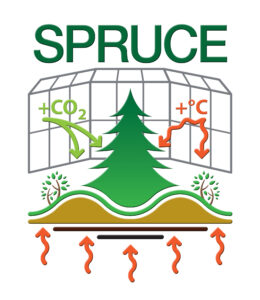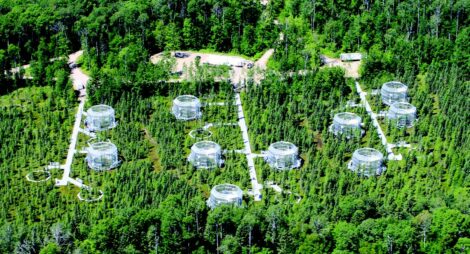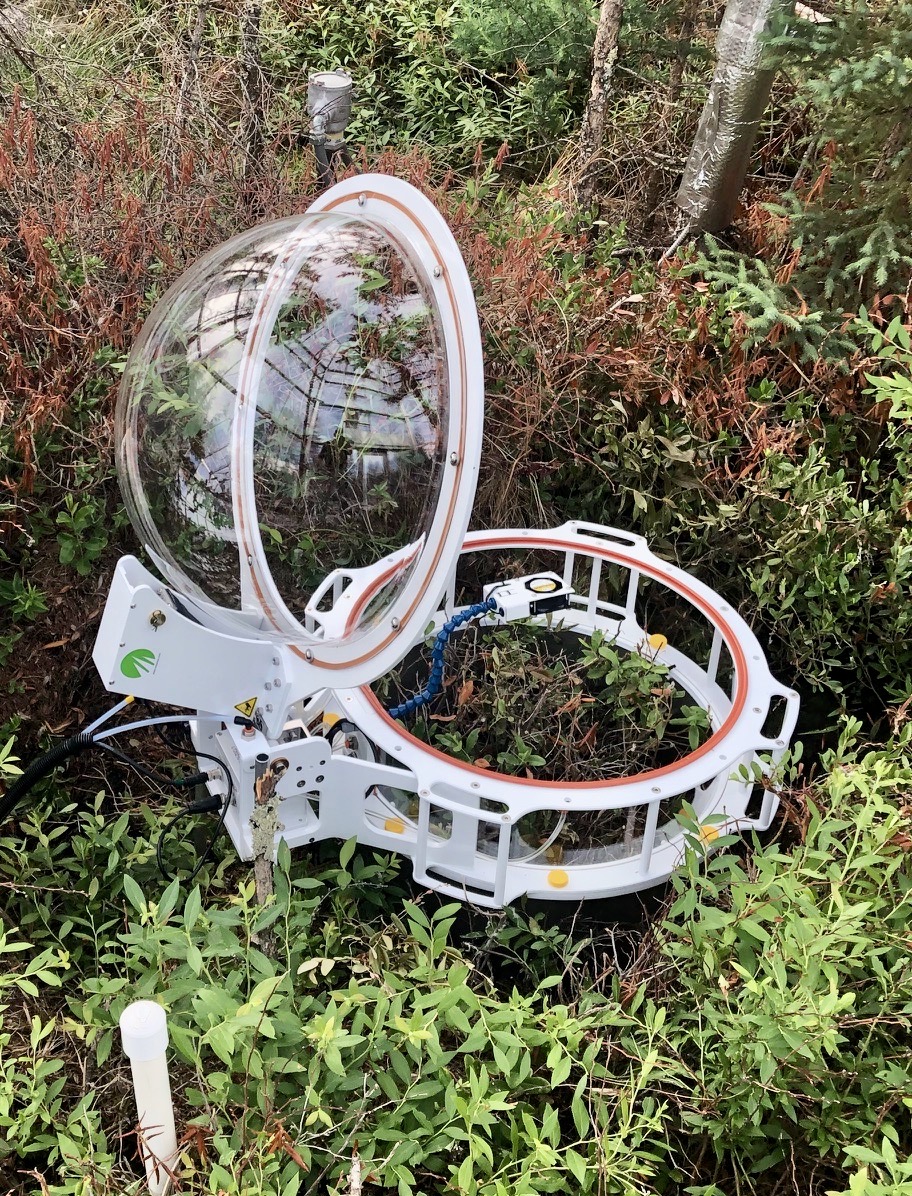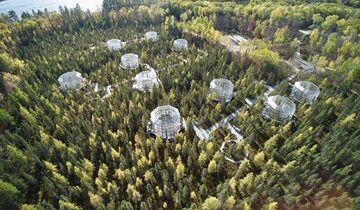An experiment to assess the response of northern peatland ecosystems to increases in temperature and exposures to elevated atmospheric CO2 concentrations
Project website | Overview brochure PDF | Podcast
| Podcast
Principal investigator: Paul J. Hanson
Peatlands cover only 3% of Earth’s land surface but contain about 30% of the global soil carbon pool. Peat deposits originated from higher plants and moss-generated litter. Because of cold, oxygen-poor conditions, the carbon contained in northern peatlands has accumulated for thousands of years. Under current warming trends and consistent with climate projections, such accumulations of carbon may be vulnerable to further decomposition or mineralization. If global temperatures warm as projected at higher latitudes, these peatlands could release large amounts of greenhouse gases such as carbon dioxide (CO2) and methane (CH4) that could accelerate global warming. The ability to predict or simulate the fate of the stored carbon in response to environmental disruption remains hampered by a limited understanding of the controls of carbon turnover and the composition and functioning of peatland ecosystems.

Aerial View of SPRUCE Project Site. SPRUCE research is being conducted on an 8.1-hectare peatland of the Marcell Experimental Forest in northern Minnesota. 10 open-topped aboveground enclosures (12 m in diameter) are being used to simulate various levels of warming and carbon dioxide exposure. The remote landscape includes a mix of uplands, bogs, fens, lakes, and streams.
To identify and quantify these critical environmental response mechanisms, the Environmental System Science (ESS) program within the Department of Energy’s (DOE) Biological and Environmental Research (BER) program is supporting a whole-ecosystem experiment in an ombrotrophic bog (i.e., a raised bog that receives all water and nutrients from direct precipitation) located in the Marcell Experimental Forest of northern Minnesota. The Spruce and Peatland Responses Under Changing Environments (SPRUCE) experiment project, led by Oak Ridge National Laboratory (ORNL), enables the assessment of ecological responses across multiple spatial scales—including microbial communities, moss populations, various higher plant types, and some insect groups. The project is evaluating a wide range of increased temperatures and levels of elevated atmospheric CO2 concentrations. Direct and indirect effects of the experimental perturbations are being tracked and analyzed over a decade. This comprehensive suite of spruce-peatland process studies and observations is being linked to model development and application requirements for improving process representation, calibrating models, and evaluating model predictions for boreal ecosystems. SPRUCE is a cooperative joint venture by scientists from DOE national laboratories, the U.S. Department of Agriculture’s (USDA) Forest Service, and universities.
Key Science Questions
The experiment’s overarching science questions cover ecosystem responses ranging from the microbe to landscape scale. They include:
- Will future warming release 10,000 years of accumulated carbon from peatlands that store one-third of Earth’s terrestrial carbon? At what rate?
- Will these carbon releases be in the form of carbon dioxide or methane with 30 times the warming potential?
- Are peatland ecosystems and organisms vulnerable to atmospheric and environmental change? What changes are likely?
- Will ecosystem services (e.g., regional water balance) be compromised or enhanced by atmospheric and climatic change?
Answers to these questions will provide insights not only for small-scale processes but also for landscape-relevant water, carbon, and energy fluxes for similar peatlands. Results will inform higher-order models of vegetation responses under various levels of climatic warming and associated end-of-century atmospheric change.

Whole-Ecosystem Warming Method. Experimental enclosures were built to provide warming from the treetops to the deep soil (–2 m to –3 m). The open-topped enclosures encompass 12-m diameter internal study areas, with 8-m tall side walls. A subsurface corral isolates the belowground peat environment for measures of local hydrologic conditions. Aboveground warming enclosures became fully operational in 2015.
Warming and CO2 Treatments
By 2100, future terrestrial environments are projected to be 4°C to 8°C warmer than today, depending on the latitude. Mean deep soil (> 1 m) temperatures will also rise with a warming climate. A series of large, open-topped aboveground enclosures and a method for warming soils from the surface down to a minimum of 2 m were installed in the peatland to simulate various levels of warming and CO2 exposure at the whole-ecosystem scale. Soil and air temperatures within these enclosures cover multiple levels of warming from ambient to +9°C. Simultaneously, atmospheric CO2 levels within half of the enclosures are elevated up to 800 to 900 parts per million to reflect current expectations for levels that could be associated with end-of-century temperatures.
The experimental system provides a unique platform for testing the mechanisms controlling the vulnerability of organisms, biogeochemical processes, and ecosystem functions to important environmental change variables (e.g., thresholds of organisms to decline or mortality, limitations to regeneration, biogeochemical limitations to productivity, and the cycling and release of CO2 and CH4 to the atmosphere). The ultimate goal is to determine the levels of warming at which ecosystems will reach a critical change in temperature and what CO2 levels will push them into a new state (i.e., altered community composition and capacity to store carbon). Deep peatland heating was initiated in June 2014 to independently test the impacts of warming on the bog’s ancient deep carbon stocks ahead of the full whole-ecosystem warming that began in June 2015.
Connecting Observations to Models for Improved Earth System Predictions

Environmental Monitoring. Automated ground-level measurements of carbon dioxide and methane are assessed from 0.5-m diameter in situ collars left in the experimental plots for seasonal and treatment response evaluations.
New modeling approaches for peatlands are needed to incorporate the complex relationships among warming, drying, mineralization processes, and vegetation responses associated with environmental changes. The experimental data generated by SPRUCE are providing quantitative evidence of the effects of elevated temperatures and CO2 on northern peatland ecosystems and the vast carbon stores associated with the hydrology and biogeochemistry of these globally widespread landscapes. These data have led to key improvements in how biogeochemistry models (and further community models) represent the temperature dependence of carbon losses as CO2 and CH4. Models have also improved the extent to which they might be counterbalanced by enhanced net primary production that is driven by a longer growing season, nutrient enrichment, and elevated atmospheric CO2 levels.
Research Platform for the Scientific Community
The core suite of SPRUCE research is being pursued by scientists at ORNL and the USDA’s Forest Service. Collaborations with over 30 universities have been established to leverage the project. Also welcomed are new initiatives consistent with the design, science mission, spatial constraints, and integrity of the experiment on the sensitive bog ecosystem. Collaboration opportunities include but are not limited to:
- Canopy albedo changes
- Remote sensing of canopy function
- Microscale LIDAR
- Cold hardiness
- Trace gas emissions
- Herbivory
- Food web linkages
- Pests and pathogens (host defenses versus pathogen virulence)
For more information on how to become involved with the SPRUCE project, go to mnspruce.ornl.gov/contact.
Videos

SPRUCE Shows Impacts of Climate Change Scenarios
In celebration of Earth Day 2022, SPRUCE researchers talked with Ben Tracy from CBS Morning about the experiment and how it’s providing a window into the future of peatlands affected by climate change. (2022)
